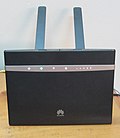Wi-Fi
Wi-Fi is a way of connecting to a computer network using radio waves instead of wires. It was invented to connect computers that are near each other, and nowadays is much used for Internet connections.
 The old Wi-Fi Alliance logo. | |
| Introduced | September 1998 |
|---|---|
| Compatible hardware | Personal computers, gaming consoles, televisions, printers, mobile phones, tablets. |
The Wi-Fi Alliance says Wi-Fi is any "wireless local area network" (WLAN) that follows the Institute of Electrical and Electronics Engineers' (IEEE) 802.11 specification. A Wi-Fi device can work with any Wi-Fi network anywhere in the world.
The word Wi-Fi is a play on words with hi-fi, and was invented to replace the name "IEEE 802.11b Direct Sequence Spread Spectrum".[1][2][3]
As of 2013, most wireless networks use one of two radio frequency bands. These are not the only two bands, but are the most used. One of the bands is at around 2.4 GHz, and the other is at 5 GHz. Both of these have benefits and drawbacks: The 2.4 GHz band is widely used, and devices are usually cheaper. Microwave ovens, DECT telephones and other wireless devices also use the 2.4 GHz band, and sometimes cause interference which slows transmissions. The 5 GHz band has more frequencies and usually less interference, but there are more rules for using it. In some places, the 5 GHz band may not be used outdoors. Because fewer devices use the 5 GHz band, devices that do are often more expensive.
The World Health Organization (WHO) says that Wi-Fi is not dangerous.[4][5]
Wi-Fi Media
Wi-Fi Certified products have to demonstrate that they can perform well in networks with other Wi-Fi Certified products, running common applications, in situations similar to those encountered in everyday use. Certification employs 3 principles: Interoperability is the primary target of certification.
An example of a service set called WiFi Wikipedia consisting of two basic service sets. The clients automatically roam between the two BSSs without the user having to explicitly connect to the second network.
This Netgear Wi-Fi router contains dual bands for transmitting the 802.11 standards across the 2.4 and 5 GHz spectrums and supports MIMO.
Related pages
References
- ↑ "WiFi isn't short for "Wireless Fidelity"". boingboing.net. 2005-11-08. Archived from the original on November 24, 2005. Retrieved 2007-08-31.
- ↑ "Wireless Fidelity' Debunked". Wi-Fi Planet. 2007-04-27. Retrieved 2007-08-31.
- ↑ "What is the True Meaning of Wi-Fi?". Teleclick. Archived from the original on 2012-09-11. Retrieved 2007-08-31.
- ↑ "Electromagnetic Hypersensitivity (EMS)", 2011
- ↑ Q&A: Wi-fi health concerns, BBC News
Other websites
- Wi-Fi Alliance Archived 2009-10-07 at the Wayback Machine
- Free WiFi - A list of free Wi-Fi around the world








